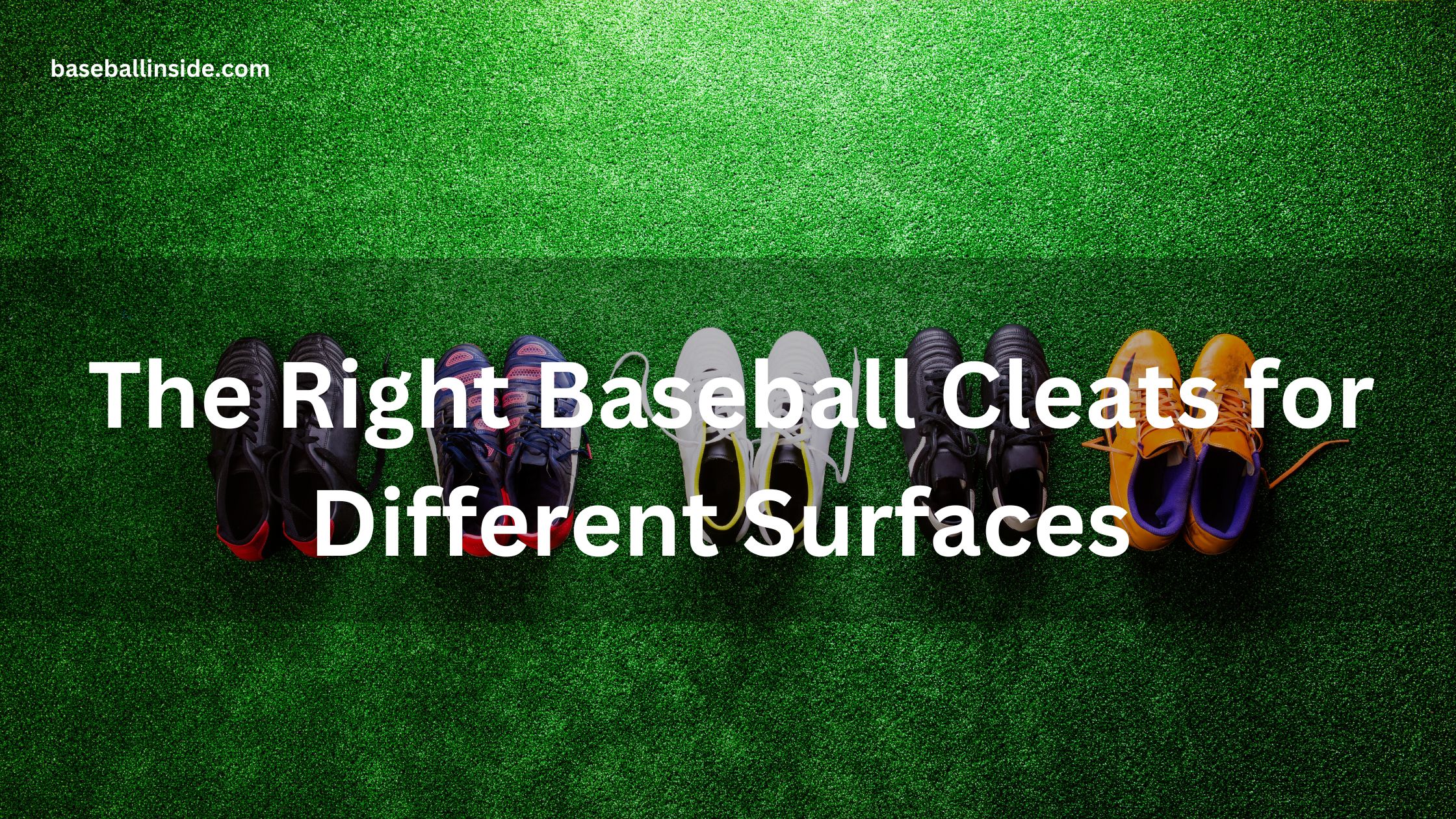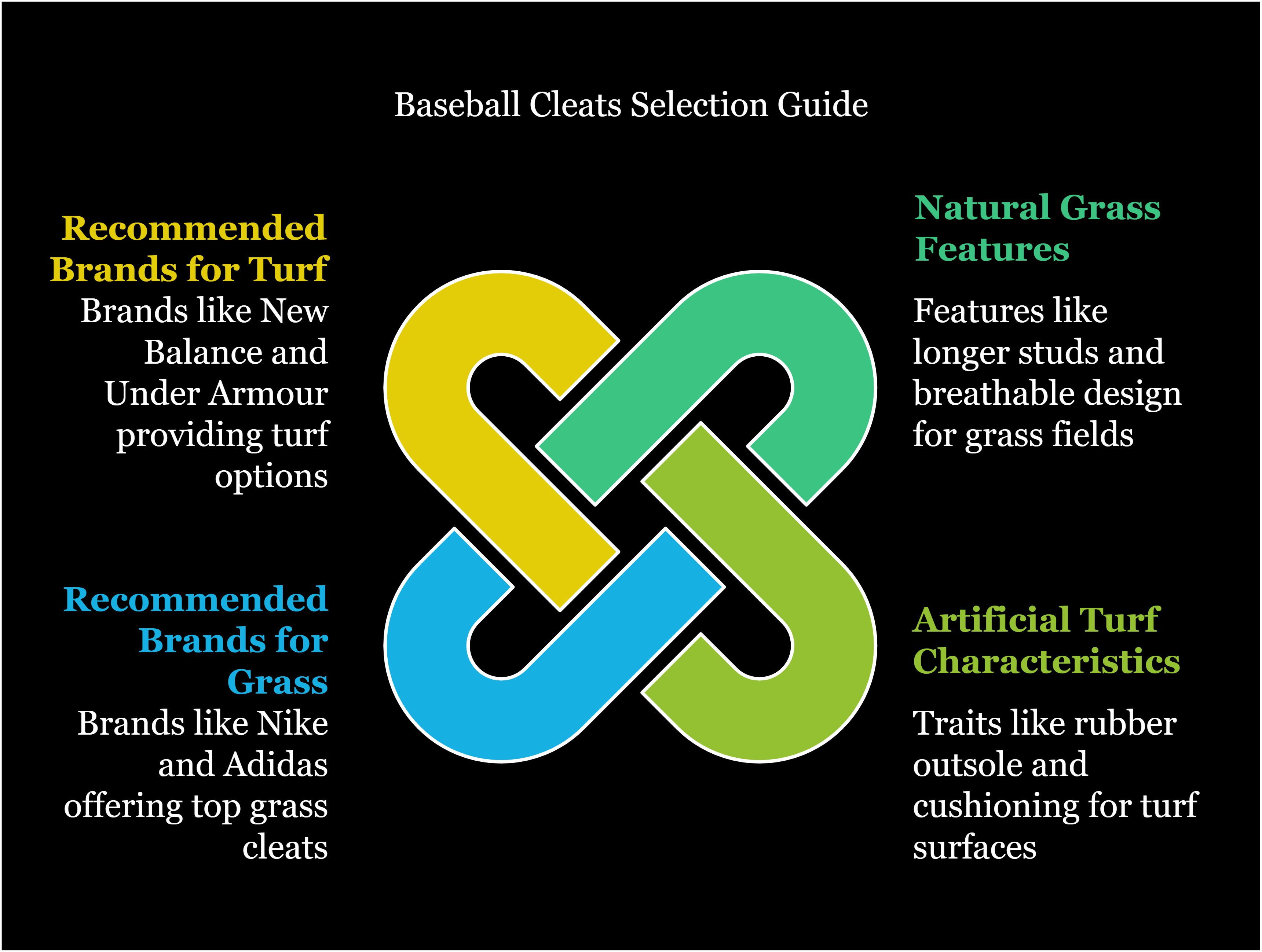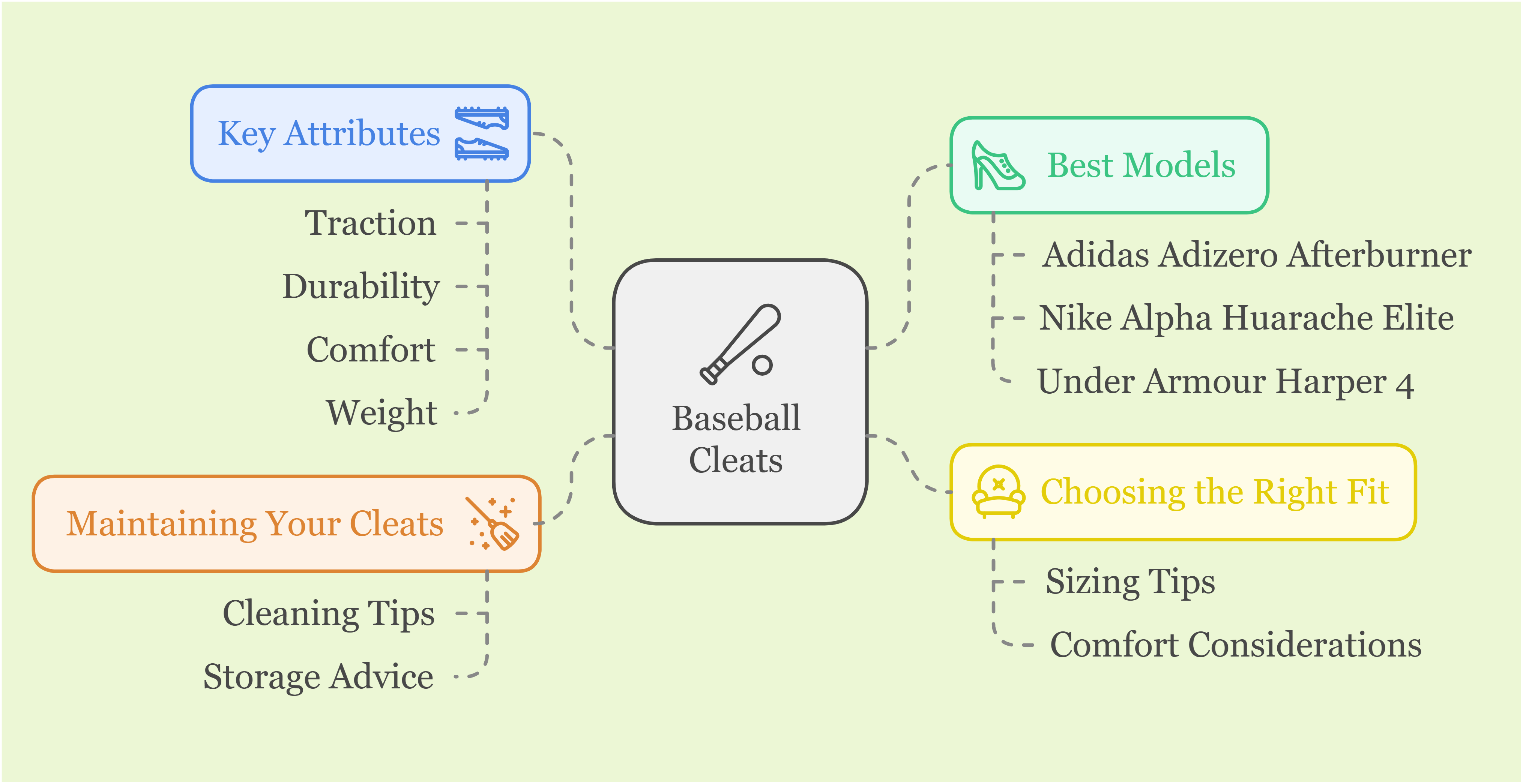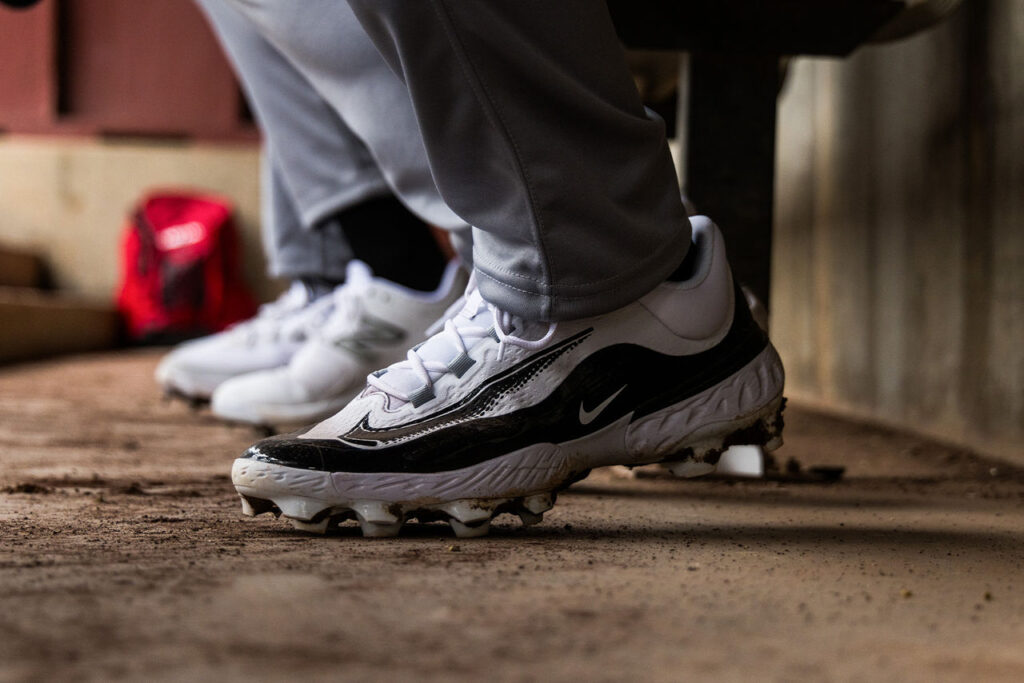Choose molded cleats for grass and turf surfaces. Opt for metal cleats for firm, dry fields to enhance traction.To Choose the Right Baseball Cleats for Different Surfaces.
Selecting the right baseball cleats is crucial for performance and safety. Different surfaces require specific types of cleats to maximize grip and prevent injuries. Molded cleats are versatile and suitable for both grass and turf. They provide consistent traction and are less likely to damage the field.
On the other hand, metal cleats offer superior grip on firm, dry surfaces, making them ideal for advanced players who need precise movements. Understanding these distinctions helps players maintain agility and stability, ensuring they play their best game. Always consider the playing surface before making a purchase to enhance your on-field performance.
Importance Of Choosing The Right Cleats
Choosing the right baseball cleats is crucial. It impacts your performance and safety on the field. The wrong cleats can lead to discomfort, poor play, and injuries.
Impact On Performance
Baseball is a game of speed and agility. The right cleats give you better traction on different surfaces. This helps you run faster and make sharp turns easily.
Cleats with metal spikes are ideal for grass fields. They dig into the grass and provide the best grip. Molded cleats are better for artificial turf. They offer more comfort and still provide good traction.

Injury Prevention
Wearing the right cleats can prevent injuries. Poor traction can lead to slips and falls. The right cleats keep you stable and balanced.
Cleats with the wrong fit can cause blisters and foot pain. Always choose cleats that fit well. This ensures you stay comfortable and injury-free during the game.
| Surface | Recommended Cleats |
|---|---|
| Grass | Metal Spikes |
| Artificial Turf | Molded Cleats |
| Clay | Rubber Cleats |
Remember, choosing the right cleats can make a huge difference. It improves your game and keeps you safe on the field.
Types Of Baseball Cleats
Choosing the right baseball cleats is crucial for performance. Different surfaces require different types of cleats. This section covers the four main types of baseball cleats.
Metal Cleats
Metal cleats are great for firm, natural grass fields. They provide excellent traction and grip. Many professional players prefer metal cleats. They have sharp, thin metal spikes.
| Pros | Cons |
|---|---|
| Outstanding traction | Can be uncomfortable |
| Durable | Not suitable for all surfaces |
Molded Cleats
Molded cleats have plastic or rubber studs. They are versatile and work on various surfaces. They are also more comfortable than metal cleats.
- Good for young players
- More affordable
- Safe on different surfaces
Turf Shoes
Turf shoes are best for artificial turf. They have short, rubbery nubs. These cleats provide good grip and are very comfortable.
- Safe for indoor fields
- Great for practice
- Reduce injury risk
Interchangeable Cleats
Interchangeable cleats offer flexibility. You can change the studs based on the surface. They are convenient but can be expensive.
| Pros | Cons |
|---|---|
| Adaptable to different fields | Higher cost |
| Customizable | More maintenance |
Understanding Different Playing Surfaces
Choosing the right baseball cleats depends on the playing surface. Different surfaces require different cleats for optimal performance and safety. Let’s explore the main surfaces: natural grass, artificial turf, and dirt infields.

Natural Grass
Natural grass fields are common in baseball. Cleats for natural grass need good traction. Metal spikes or molded cleats work best here. Metal spikes provide excellent grip, especially on wet grass. Molded cleats offer comfort and stability. They are also suitable for young players.
Artificial Turf
Artificial turf is different from natural grass. It is harder and more consistent. Cleats with shorter, rubber studs are ideal. These provide traction without damaging the turf. Turf shoes are also a great option. They have small rubber nubs for grip and comfort.
Dirt Infields
Dirt infields need specific cleats for best performance. Molded cleats or metal spikes are suitable. Metal spikes dig into the dirt, offering great traction. Molded cleats offer comfort and are less aggressive. They are a good choice for younger players or those seeking comfort.
| Surface | Recommended Cleats |
|---|---|
| Natural Grass | Metal Spikes, Molded Cleats |
| Artificial Turf | Rubber Studs, Turf Shoes |
| Dirt Infields | Metal Spikes, Molded Cleats |
Choose the right cleats for your surface to improve your game. The right cleats provide better traction, comfort, and safety.
Cleats For Natural Grass
Choosing the right baseball cleats for natural grass is essential. The right cleats improve performance and prevent injuries. Natural grass fields are common, and they need specific features in cleats.

Best Features
Cleats for natural grass must have certain features. Here are some key points:
- Longer Studs: Provide better grip on soft, uneven surfaces.
- Durable Materials: Ensure the cleats last longer.
- Breathable Design: Keeps your feet cool and dry.
- Comfortable Fit: Reduces the risk of blisters and discomfort.
Top Recommendations
Here are some top recommendations for cleats suitable for natural grass:
| Brand | Model | Key Features |
|---|---|---|
| Nike | Vapor Ultrafly 4 | Lightweight, excellent traction, breathable |
| Adidas | Adizero Afterburner 8 | Durable, comfortable fit, great grip |
| Under Armour | Harper 5 | Supportive, long studs, stylish design |
These cleats offer the best combination of features for natural grass. They ensure you perform your best on the field.
Cleats For Artificial Turf
Choosing the right baseball cleats for artificial turf is crucial. The surface is different from natural grass. The cleats need specific features to perform well. Here’s a guide to help you make the best choice.
Ideal Characteristics
Baseball cleats for artificial turf should have certain characteristics. Traction is key. The cleats should grip the turf without digging in. Comfort is also important. Artificial turf can be hard on the feet. Durability matters as well. Turf can wear down cleats quickly.
Look for cleats with a rubber outsole. This provides the best grip. The cleats should also have cushioning. This helps absorb the impact from the hard surface. Lightweight cleats are preferable. They make running easier and faster.
Popular Choices
Several brands offer great cleats for artificial turf. Here are some popular options:
- Nike Alpha Huarache Elite 3 Turf: These cleats are known for their comfort and durability.
- Adidas Icon V Turf: These offer excellent traction and lightweight design.
- New Balance 3000v5 Turf: These provide superior cushioning and support.
- Under Armour Yard Turf: These are highly durable and comfortable for long games.
Each of these choices has its strengths. Consider your specific needs. This will help you choose the best cleats for artificial turf.
Cleats For Dirt Infields
Choosing the right baseball cleats for dirt infields can be challenging. Dirt infields require cleats that offer excellent traction and stability. This ensures players can move quickly and efficiently.

Key Attributes
When selecting cleats for dirt infields, consider these key attributes:
- Traction: Cleats should provide a firm grip on loose dirt.
- Durability: Look for materials that withstand wear and tear.
- Comfort: Ensure the cleats fit well and provide ample support.
- Weight: Lightweight cleats help in faster movements.
Best Models
Here are some of the best models suitable for dirt infields:
| Model | Key Features |
|---|---|
| Adidas Adizero Afterburner | Lightweight, excellent traction, durable material |
| Nike Alpha Huarache Elite | Comfortable fit, strong grip, breathable fabric |
| Under Armour Harper 4 | Great support, high durability, superior traction |
These models offer the best balance of traction, comfort, and durability. They are designed to help you perform at your best on dirt infields.

Choosing The Right Fit
Finding the perfect baseball cleats is essential for performance and comfort. The right fit ensures you stay agile and avoid injuries. Let’s explore how to choose the right fit for your baseball cleats.
Sizing Tips
Proper sizing is crucial. Here are some tips:
- Measure your feet at the end of the day.
- Wear the socks you play in when sizing.
- There should be a thumb’s width between your toes and the cleat’s tip.
Use the table below to find your size:
| Foot Length (inches) | US Size | EU Size |
|---|---|---|
| 9.25 | 6 | 38.5 |
| 9.5 | 7 | 40 |
| 9.75 | 8 | 41 |
| 10 | 9 | 42 |
Comfort Considerations
Comfort is key for long games and practices. Consider these points:
- Material: Choose breathable materials.
- Padding: Look for well-padded insoles.
- Flexibility: Ensure the cleats bend with your foot.
Break in your cleats before a big game. This helps avoid blisters and discomfort.
If possible, try different brands. Each brand fits differently.
Maintaining Your Cleats
Proper maintenance of your baseball cleats extends their lifespan and ensures better performance. Clean and store your cleats properly to keep them in top shape. Below are some essential tips for maintaining your cleats.

Cleaning Tips
Regular cleaning prevents dirt buildup and maintains traction. Follow these steps to clean your cleats:
- Remove excess dirt: Use a soft brush to scrape off mud and dirt.
- Wash with mild soap: Mix water with mild soap and scrub gently.
- Rinse thoroughly: Make sure no soap residue is left.
- Dry properly: Air-dry your cleats at room temperature. Avoid direct sunlight.
Storage Advice
Storing your cleats correctly helps maintain their shape and quality. Follow these storage tips:
- Clean before storing: Always store clean and dry cleats.
- Use a shoe bag: Keep your cleats in a breathable shoe bag.
- Avoid damp places: Store in a dry, cool area to prevent mold.
- Stuff with paper: Use paper inside the cleats to retain their shape.
Proper cleaning and storage will keep your baseball cleats in excellent condition. Following these tips ensures your cleats are always ready for the game.
Frequently Asked Questions
What Are The Types Of Baseball Cleats?
There are three main types: metal, molded, and turf cleats. Metal cleats offer the best grip. Molded cleats are versatile and durable. Turf cleats are ideal for training on artificial surfaces.
Which Cleats Are Best For Grass Fields?
Metal cleats are best for grass fields. They provide excellent traction and stability. This helps prevent slipping. However, they are not recommended for all players due to safety concerns.
How To Choose Cleats For Artificial Turf?
Turf cleats are ideal for artificial turf. They have small rubber studs. This provides better grip and reduces the risk of injury. They are also comfortable for extended play.
Can I Use Molded Cleats On All Surfaces?
Molded cleats are versatile and can be used on most surfaces. They offer good traction on both grass and turf. However, they may not provide the best grip on wet grass.
Conclusion
Choosing the right baseball cleats enhances performance and safety on various surfaces. Assess your needs and preferences carefully. Consider factors like material, fit, and surface type. Proper cleats can make a significant difference. Invest in quality footwear to excel in your game.
Make informed choices for a better baseball experience.


